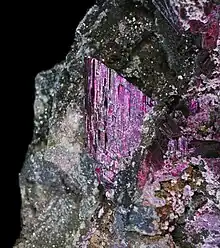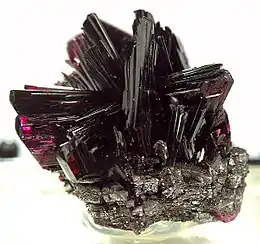Erythrite
Erythrite or red cobalt is a secondary hydrated cobalt arsenate mineral with the formula Co
3(AsO
4)
2•8H
2O. Erythrite and annabergite, chemical formula Ni
3(AsO
4)
2•8H
2O, or nickel arsenate form a complete series with the general formula (Co,Ni)
3(AsO
4)
2•8H
2O.

| Erythrite | |
|---|---|
 Erythrite crystals | |
| General | |
| Category | Arsenate mineral |
| Formula (repeating unit) | Co3(AsO4)2·8H2O |
| IMA symbol | Ery[1] |
| Strunz classification | 8.CE.40 |
| Dana classification | 40.03.06.03 |
| Crystal system | Monoclinic |
| Crystal class | Prismatic (2/m) (same H-M symbol) |
| Space group | C2/m |
| Identification | |
| Color | Crimson to peach-red, pale rose, or pink, may be zoned |
| Crystal habit | Radial or stellate aggregates, fibrous, drusy; usually powdery and massive - rarely as striated prismatic crystals |
| Cleavage | Perfect on {010}; poor on {100} and {102}. |
| Tenacity | Sectile |
| Mohs scale hardness | 1.5 - 2.5 |
| Luster | Subadamantine, pearly on cleavages |
| Streak | Pale red to pink |
| Diaphaneity | Transparent to translucent |
| Specific gravity | 3.06 |
| Optical properties | Biaxial (+) |
| Refractive index | nα = 1.626 - 1.629 nβ = 1.662 - 1.663 nγ = 1.699 - 1.701 |
| Birefringence | δ = 0.073 |
| Pleochroism | Visible: X = pale pinkish to pale rose; Y = pale violet to pale violet-rose; Z = deep red |
| References | [2][3][4] |
Erythrite crystallizes in the monoclinic system and forms prismatic crystals. The color is crimson to pink and occurs as a secondary coating known as cobalt bloom on cobalt arsenide minerals. Well-formed crystals are rare, with most of the mineral manifesting in crusts or small reniform aggregates.
Erythrite was first described in 1832 for an occurrence in Grube Daniel, Schneeberg, Saxony,[4] and takes its name from the Greek έρυθρος (erythros), meaning red.[3] Historically, erythrite itself has not been an economically important mineral, but the prospector may use it as a guide to associated cobalt and native silver.
Erythrite occurs as a secondary mineral in the oxide zone of Co–Ni–As bearing mineral deposits. It occurs in association with cobaltite, skutterudite, symplesite, roselite-beta, scorodite, pharmacosiderite, adamite, morenosite, retgersite, and malachite.[2]
Notable localities are Cobalt, Ontario; La Cobaltera, Chile, Schneeberg, Saxony, Germany; Joachimsthal, Czech Republic; Cornwall, England; Bou Azzer, Morocco; the Blackbird mine, Lemhi County, Idaho; Sara Alicia mine, near Alamos, Sonora, Mexico; Mt. Cobalt, Queensland and the Dome Rock copper mine, Mingary, South Australia.[2]
Other varieties
The nickel variety, annabergite, occurs as a light green nickel bloom on nickel arsenides. In addition iron, magnesium and zinc can also substitute for the cobalt position, creating three other minerals: parasymplesite (Fe), hörnesite (Mg) and köttigite (Zn).
References
- Warr, L.N. (2021). "IMA–CNMNC approved mineral symbols". Mineralogical Magazine. 85 (3): 291–320. Bibcode:2021MinM...85..291W. doi:10.1180/mgm.2021.43. S2CID 235729616.
- Anthony, John W.; Bideaux, Richard A.; Bladh, Kenneth W.; Nichols, Monte C. (2005). "Erythrite" (PDF). Handbook of Mineralogy. Mineral Data Publishing. Retrieved 27 July 2022.
- Erythrite, Mindat.org, retrieved 27 July 2022
- Barthelmy, David (2014). "Erythrite Mineral Data". Webmineral.com. Retrieved 27 July 2022.
Further reading
- Dana's Manual of Mineralogy ISBN 0-471-03288-3
- Manual of Mineral Science, 22nd Ed. C. Klein.ISBN 0-471-25177-1
- Faye, G H; Nickel, E H (1968). "The origin of pleochroism in erythrite" (PDF). The Canadian Mineralogist. 9: 492–504.